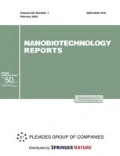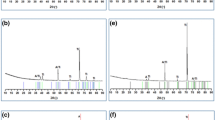Abstract—Highly ordered films from individual TiO2 nanotubes (NTs) with controlled geometric characteristics were obtained by potentiostatic anodization of titanium in an electrochemical cell with flow-through circulation of the solution and a cooling system for it placed outside the cell at a temperature of 25 ± 0.5°C. The study shows how a wide concentration range of water (0–15%) and ammonium fluoride (0.1–2.0%) in ethylene glycol (EG) influences the morphology and composition of the obtained TiO2 NTs. It was found that the most ordered structure of TiO2 NTs forms when the water content in the anodizing solution is 0.5–4.0% and the proportion of NTs in the hexagonal coordination reaches 75%. It is shown that fluoride ion and water concentration in EG do not affect the chemical state and concentration of elements in the resulting nanostructures. X-ray photoelectron spectroscopy revealed that titanium in the obtained samples is in the form Ti4+ and Ti3+ with a relative proportion of the latter of 8 ± 2%.



Similar content being viewed by others
REFERENCES
J. M. Macak, H. Hildebrand, U. Marten-Jahns, and P. Schmuki, J. Electroanal. Chem. 621, 254 (2008).
K. Indira, U. Kamachi, T. Mudali, et al., J. Bio-Tribocorros. 28 (1), 1 (2015).
T. N. Patrusheva, V. A. Fedyaev, S. D. Kirik, et al., Theor. Found. Chem. Eng. 51, 759 (2017).
K. Ryota, K. Yasuo, B. Mitsuo, et al., J. Electrochem. Soc. 159, 629 (2012).
V. A. Nebol’sin, B. A. Spiridonov, A. I. Dunaev, and E. V. Bogdanovich, Inorg. Mater. 53, 595 (2017).
D. I. Petukhov, A. A. Eliseev, I. V. Kolesnik, et al., Microporous Mesoporous Mater. 114, 440 (2008).
M. Atsunori, S. Srimala, and K. Warapong, J. Asian Ceram. Soc., No. 1, 203 (2013).
Xie Quan, Shaogui Yang, Xiuli Ruan, and Huiming Zhao, Environ. Sci. Technol. 39, 3770 (2005).
S. Noothongkaew, H. Jung Kyun, O. Thumtan, and K.-S. An, Mater. Lett. 233, 153 (2018).
Ghafar Ali, Chong Chen, Seung Hwa Yoo, et al., Nanoscale Res. Lett., No. 6, 332 (2011).
G. D. Sulka, J. Kapusta-Kolodziej, A. Brzózka, and M. Jaskuła, Electrochim. Acta 55, 4359 (2010).
P. Acevedo-Pena, L. Lartundo-Rojas, and I. Gonzalez, J. Solid State Electrochem. 17, 2939 (2013).
D. I. Petukhov, A. A. Eliseev, I. V. Kolesnik, et al., J. Porous Mater. 19, 71 (2012).
N. A. Belich, A. V. Grigor’eva, D. I. Petukhov, A. V. Sidorov, A. E. Gol’dt, and E. A. Gudilin, Nanotechnol. Russ. 10, 345 (2015).
Z. Jedi-Soltanabadi, M. Ghoranneviss, Z. Ghorannevis, and H. Akbari, Vacuum 155, 387 (2018).
S. Ozkan, A. Mazare, and P. Schmuki, Electrochim. Acta 268, 435 (2018).
X. Wang, Ya. Li, H. Song, et al., RSC Adv., No. 6, 8333 (2016).
Y. Sun, Q. Zhao, G. Wang, and K. Yan, J. Alloys Compd. 711, 514 (2017).
Yujing Xue, Yan Sun, Guixin Wang, et al., Electrochim. Acta 155, 312 (2015).
E. O. Gordeeva, I. V. Roslyakov, A. I. Sadykov, T. A. Suchkova, D. I. Petukhov, T. B. Shatalova, and K. S. Napolskii, Russ. J. Electrochem. 54, 990 (2018).
D. A. Buldakov, D. I. Petukhov, I. V. Kolesnik, A. A. Eliseev, A. V. Lukashin, and Yu. D. Tret’yakov, Nanotechnol. Russ. 4, 296 (2009).
K. Suriye, P. Praserthdam, and B. Jongsomjit, Appl. Surf. Sci. 253, 3849 (2007).
P. Wang, P.-S. Yap, and T.-T. Lim, Appl. Catal. A 399, 252 (2011).
ACKNOWLEDGMENTS
The authors are grateful to the staff of Mendeleev University of Chemical Technology for the study of samples using SEM.
Funding
The study was supported by the Russian Science Foundation (project no. 19-73-00192).
Author information
Authors and Affiliations
Corresponding author
Rights and permissions
About this article
Cite this article
Morozov, A.N., Denisenko, A.V., Mihaylichenko, A.I. et al. Influence of Electrolyte Composition on Morphology of Titanium Dioxide Films Obtained by Titanium Anodization in a Circulated Mixing Cell. Nanotechnol Russia 14, 444–450 (2019). https://doi.org/10.1134/S1995078019050100
Received:
Revised:
Accepted:
Published:
Issue Date:
DOI: https://doi.org/10.1134/S1995078019050100




